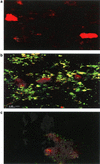Detection of Rickettsia prowazekii in body lice and their feces by using monoclonal antibodies
- PMID: 12202579
- PMCID: PMC130794
- DOI: 10.1128/JCM.40.9.3358-3363.2002
Detection of Rickettsia prowazekii in body lice and their feces by using monoclonal antibodies
Abstract
In order to identify Rickettsia prowazekii in lice, we developed a panel of 29 representative monoclonal antibodies selected from 187 positive hybridomas made by fusing splenocytes of immunized mice with SP2/0-Ag14 myeloma cells. Immunoblotting revealed that 15 monoclonal antibodies reacted with the lipopolysaccharide-like (LPS-L) antigen and 14 reacted with the epitopes of a 120-kDa protein. Only typhus group rickettsiae reacted with the monoclonal antibodies against LPS-L. R. felis, a recently identified rickettsial species, did not react with these monoclonal antibodies, confirming that it is not antigenically related to the typhus group. Monoclonal antibodies against the 120-kDa protein were highly specific for R. prowazekii. We successfully applied a selected monoclonal antibody against the 120-kDa protein to detect by immunofluorescence assay R. prowazekii in smears from 56 wild and laboratory lice, as well as in 10 samples of louse feces infected or not infected with the organism. We have developed a simple, practical, and specific diagnostic assay for clinical specimens and large-scale epidemiological surveys with a sensitivity of 91%. These monoclonal antibodies could be added to the rickettsial diagnostic panel and be used to differentiate R. prowazekii from other rickettsial species.
Figures


References
-
- Bouyer, D. H., J. Stenos, P. Crocquet-Valdes, C. Moron, P. Vsevolod, J. E. Zavala-Velasquez, L. Foil, D. Stothard, A. Azad, and D. Walker. 2001. Rickettsia felis: molecular characterization of a new member of the spotted fever group. Int. J. Syst. E vol. Microbiol. 51:339-347. - PubMed
-
- Carl, M., C. W. Tibbs, M. E. Dobson, S. Paparello, and G. A. Dasch. 1990. Diagnosis of acute typhus infection using the polymerase chain reaction. J. Infect. Dis. 161:791-793. - PubMed
-
- Drobyshevskaia, E. I., I. A. Nedialkov, S. V. Spitsyn, V. Makarova, I. Tarasevich, and V. Nesterenko. 1989. Characteristics of monoclonal antibodies directed to species specific and group specific antigens of Rickettsia prowazekii. Tr. Inst. Im. Pastera 66:160-165. - PubMed
MeSH terms
Substances
LinkOut - more resources
Full Text Sources
Medical
Molecular Biology Databases

